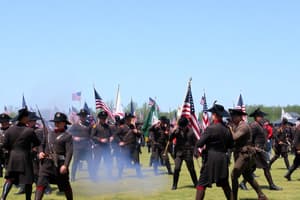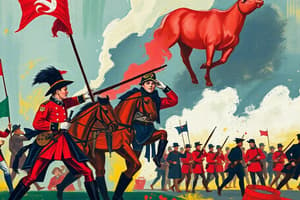Podcast
Questions and Answers
Which of the following best describes the main geographical area where the battles of the War of 1812 took place?
Which of the following best describes the main geographical area where the battles of the War of 1812 took place?
- Exclusively in the United States territories along the border with British North America.
- Across various locations in Europe and North America equally.
- Mainly in Upper and Lower Canada, with Upper Canada experiencing more key battles. (correct)
- Primarily in the Maritimes, with some skirmishes in Lower Canada.
Approximately how many battles, raids, skirmishes, and campaigns occurred during the War of 1812?
Approximately how many battles, raids, skirmishes, and campaigns occurred during the War of 1812?
- Fewer than 50.
- More than 170. (correct)
- Around 100.
- Close to 500.
What was a primary challenge in determining the exact number of casualties during the War of 1812?
What was a primary challenge in determining the exact number of casualties during the War of 1812?
- Official records were imprecise and incomplete. (correct)
- The battles were fought on several continents simultaneously.
- There was reluctance to report casualties on either side.
- The war ended too quickly to keep accurate records.
What was the significance of Detroit at the start of the War of 1812, according to the text?
What was the significance of Detroit at the start of the War of 1812, according to the text?
What was General Hull's strategy regarding the colonists of Upper Canada, and what was its outcome?
What was General Hull's strategy regarding the colonists of Upper Canada, and what was its outcome?
Despite being outnumbered, what factor significantly contributed to the British victory at Detroit?
Despite being outnumbered, what factor significantly contributed to the British victory at Detroit?
What crucial alliance was solidified by the British victory at Detroit?
What crucial alliance was solidified by the British victory at Detroit?
What role did naval power play in the British victory at Detroit?
What role did naval power play in the British victory at Detroit?
What strategic advantage did Niagara present to the Americans during the War of 1812?
What strategic advantage did Niagara present to the Americans during the War of 1812?
Which of the following factors contributed to the weakening of American forces at Queenston Heights?
Which of the following factors contributed to the weakening of American forces at Queenston Heights?
Why was York (present-day Toronto) considered a strategic target for the Americans?
Why was York (present-day Toronto) considered a strategic target for the Americans?
What was the primary objective of the British attack on Washington, D.C. in 1814?
What was the primary objective of the British attack on Washington, D.C. in 1814?
What tactic did the British forces employ at the Battle of Châteauguay to deceive the American army?
What tactic did the British forces employ at the Battle of Châteauguay to deceive the American army?
What was the unique historical significance of the Battle of Châteauguay, regarding the composition of forces?
What was the unique historical significance of the Battle of Châteauguay, regarding the composition of forces?
What was the ultimate outcome of the Battle of Lundy’s Lane?
What was the ultimate outcome of the Battle of Lundy’s Lane?
After the Battle of Lundy's Lane, why did the Americans eventually abandon Fort Erie?
After the Battle of Lundy's Lane, why did the Americans eventually abandon Fort Erie?
What action did the Americans take before withdrawing from Fort Erie?
What action did the Americans take before withdrawing from Fort Erie?
Which of the following best describes the American strategy for the invasion of Montreal?
Which of the following best describes the American strategy for the invasion of Montreal?
What was the impact of the British retreating from York?
What was the impact of the British retreating from York?
Besides British soldiers, which group was included in the British forces during the Battle of Châteauguay?
Besides British soldiers, which group was included in the British forces during the Battle of Châteauguay?
What was the main cause of confusion during the Battle of Lundy's Lane?
What was the main cause of confusion during the Battle of Lundy's Lane?
Which Indigenous groups supported the British forces during the siege of Fort Erie?
Which Indigenous groups supported the British forces during the siege of Fort Erie?
What was the significance of burning a symbol such as the White House during the War of 1812?
What was the significance of burning a symbol such as the White House during the War of 1812?
Flashcards
What was the main theatre of the War of 1812?
What was the main theatre of the War of 1812?
The War of 1812 was a conflict between Great Britain and the United States. It involved battles in the Upper and Lower Canada. The Upper Canada suffered the most casualties due to important battles fought on its territory.
Why was the Battle of Detroit important?
Why was the Battle of Detroit important?
The Battle of Detroit was a critical victory for the British, as it allowed them to solidify their alliances with First Nations, especially with Tecumseh.
What was the result of the Battle of Detroit?
What was the result of the Battle of Detroit?
The Battle of Detroit saw the surrender of American forces under Hull, who had significantly underestimated the strength of the British forces.
What was a significant victory for the British in the War of 1812?
What was a significant victory for the British in the War of 1812?
Signup and view all the flashcards
What was considered the bloodiest battle of the War of 1812?
What was considered the bloodiest battle of the War of 1812?
Signup and view all the flashcards
What was the role of the navy in the War of 1812?
What was the role of the navy in the War of 1812?
Signup and view all the flashcards
What was the human cost of the War of 1812?
What was the human cost of the War of 1812?
Signup and view all the flashcards
What significant battle happened after the War of 1812 ended?
What significant battle happened after the War of 1812 ended?
Signup and view all the flashcards
Battle of Queenston Heights
Battle of Queenston Heights
Signup and view all the flashcards
York (Toronto)
York (Toronto)
Signup and view all the flashcards
Burning of the White House
Burning of the White House
Signup and view all the flashcards
Battle of Châteauguay
Battle of Châteauguay
Signup and view all the flashcards
Battle of Lundy's Lane
Battle of Lundy's Lane
Signup and view all the flashcards
Fort Erie
Fort Erie
Signup and view all the flashcards
HMS Sir Isaac Brock
HMS Sir Isaac Brock
Signup and view all the flashcards
Great Lakes
Great Lakes
Signup and view all the flashcards
British Forces
British Forces
Signup and view all the flashcards
American Forces
American Forces
Signup and view all the flashcards
Indigenous Allies
Indigenous Allies
Signup and view all the flashcards
British Tactics
British Tactics
Signup and view all the flashcards
Montreal
Montreal
Signup and view all the flashcards
Voltigeurs
Voltigeurs
Signup and view all the flashcards
Friendly Fire
Friendly Fire
Signup and view all the flashcards
Study Notes
Key Events of the War of 1812
- Most battles took place in Upper and Lower Canada.
- Over 170 battles, raids, skirmishes, and campaigns occurred.
- A timeline (Figure 6.18) details significant events from the war's start to its conclusion in January 1815.
- Estimated 35,000 British, American, and Indigenous combatants perished.
- Official records are inaccurate about the casualty figures.
Important Battles
-
Siege of Detroit:
- Detroit was a key location for a potential American invasion of Upper Canada.
- American General Hull's strategy to intimidate settlers into surrender failed.
- In August 1812, British forces (including Upper and Lower Canadian colonists, Maritime colonists, and Indigenous allies, led by Brock) crossed the Detroit River and attacked.
- Hull's 2500 soldiers outnumbered the British force but were overwhelmed.
- Hull surrendered, highlighting the significant naval role in the British victory (Figure 6.20).
- This early victory strengthened British alliances with Indigenous peoples, particularly with Tecumseh.
-
Battle of Queenston Heights:
- Niagara, Upper Canada, was a strategic target for American invasion.
- Americans invaded Queenston on October 13, 1812.
- Brock, leading British troops, was fatally wounded and his troops retreated.
- Reinforcements of British troops and Indigenous warriors from the Six Nations Haudenosaunee and Delaware tribes arrived, weakening the American forces.
- Militia refusal to fight across the border further weakened the American troops.
- British forces won this critical victory. (Figure 6.21)
-
Battle of York (Toronto) and Burning of Washington D.C.:
- York (Toronto) was the capital of Upper Canada and a strategic location for arms and ammunition storage.
- American forces attacked York on April 27, 1813, capturing the city, fort, and shipyard.
- A British retreat explosion and subsequent fire destroyed portions of the fort, causing casualties on both sides.
- HMS Sir Isaac Brock was burned to prevent capture.
- In retaliation, British forces attacked Washington D.C. in August 1814.
- The White House, Capitol, Library of Congress, Treasury building, and shipyard were burned.
- Only one government building remained intact after the fire. (Figure 6.22)
-
Battle of Châteauguay:
- Americans planned to invade Montreal, cutting off British supply routes between Montreal and Kingston.
- American forces were significantly larger (8 times) than opposing British forces.
- British forces (including British soldiers, French-speaking Québécois Voltigeurs, local militia, and Mohawk, Huron, and Abenaki warriors) used trickery: simulating a larger presence via sounds.
- The deception fooled the Americans into retreat.
- British forces preserved Montreal.
- First time French and English fought side-by-side on North American soil. (Figure 6.23).
-
Battle of Lundy's Lane and Siege of Fort Erie:
- Took place near Niagara Falls on July 25, 1814. Confusion led to friendly fire casualties.
- American retreat led them to defend Fort Erie.
- British forces besieged Fort Erie from August 13 to September 21, 1814.
- Further Indigenous help was enlisted from the Six Nations Haudenosaunee, Ojibwe, Mississaugas, Odawa, Wendat, and Delaware.
- British forces were unable to capture Fort Erie, retreating.
- Americans later abandoned Fort Erie and burnt it from the inside to prevent British use. (Figure 6.24)
- No clear victor in either conflict.
Studying That Suits You
Use AI to generate personalized quizzes and flashcards to suit your learning preferences.




